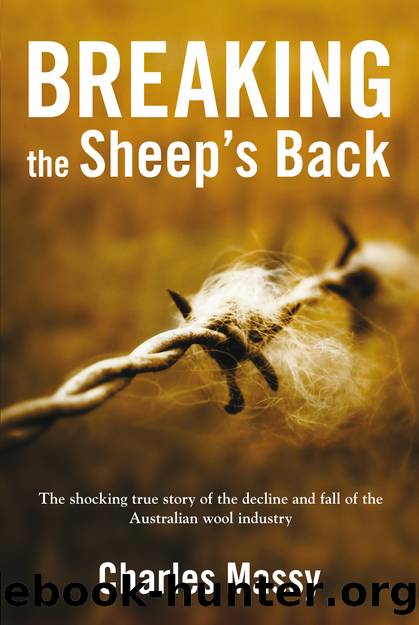Breaking the Sheep's Back by Charles Massy

Author:Charles Massy
Language: eng
Format: epub
Publisher: University of Queensland Press
Contrary to what the Chairman of the AWC told Wool Council last November, the wool industry is now in uncharted waters ⦠most of the present problems are self-inflictedâa combination of over-confidence from previous successes, people believing their own hype when a more cautious approach was called for, a little greed, and, most important, failure to appreciate the extent and rapidity of supply responses.â129
Subtly adding some pressure to the situation at NAOC, now that the lowering floor option was on the table, was Kerinâs departmental head Geoff Miller. He quietly mentioned to journalists that government approval for Corporation borrowings was not open ended, and that if the situation didnât improve the floor might have to be lowered.
Beggs told the press after his talk that the Corporation board had rejected any suggestion of reducing the floor price. He said that if the floor was cut it would need to be substantial to have any impact; that such an action would drastically hurt both growers and also customers caught with high-priced stocks; and that the growersâ stockpile would be devalued at great cost. The latter was a curious argument. The stockpile was only finally worth what the current market, and not the artificially propped-up market, said it was worth.
*
Geoff Millerâs subtle whispering tactic to the press at NAOC indicated that a policy reappraisal at government level was in the air. But not yet, and for the simple reason that Millerâs minister and office felt they could not air the issue of RPS and floor price reduction because of the imminent federal election. At the very moment when they should have been addressed, these issues became the great unmentionables.
Kerinâs economic advisor, Charles Savage, later confirmed that the decision in late 1989 to not publicly discuss or address the escalating wool problem was maintained for the duration of the election campaign. As if in corroboration of this, on Friday 16 February 1990, while in the sheep district of Young in the New South Wales south-west slopes region to campaign for Labor candidate Mick Shea, John Kerin told a meeting that â[w]e wonât flinchâ on supporting Wool Corporation borrowings. âThe industry set the price at 870, theyâve indicated they can live with that,â he said, âand I canât see any way that I should interveneâ.130
âThe two problems in this area confronting the governmentâ, said Savage subsequently, âwere not just that the RPS was a catastrophe in the making but, second, that they had a moral hazard: if they discussed the issue in public it would further destabilise the marketâ.
By early 1990, before the March election, the government, Wool Corporation and Wool Council all knew that the RPS as a sustainable statutory instrument was facing massive problemsâif it wasnât already defunct. But despite confirmatory evidence and opinion from the press, from the ACIL report, from Wool Councilâs and other dissidents, from ABARE, and even from Geoff Miller and team, still no one acted. The industry, with an unyielding government on one side and a dispassionate market on the other, was thus caught between a rock and a hard place.
Download
This site does not store any files on its server. We only index and link to content provided by other sites. Please contact the content providers to delete copyright contents if any and email us, we'll remove relevant links or contents immediately.
Life 3.0: Being Human in the Age of Artificial Intelligence by Tegmark Max(5478)
The Sports Rules Book by Human Kinetics(4298)
The Age of Surveillance Capitalism by Shoshana Zuboff(4216)
ACT Math For Dummies by Zegarelli Mark(3996)
Unlabel: Selling You Without Selling Out by Marc Ecko(3591)
Blood, Sweat, and Pixels by Jason Schreier(3567)
Hidden Persuasion: 33 psychological influence techniques in advertising by Marc Andrews & Matthijs van Leeuwen & Rick van Baaren(3476)
The Pixar Touch by David A. Price(3369)
Bad Pharma by Ben Goldacre(3358)
Urban Outlaw by Magnus Walker(3342)
Project Animal Farm: An Accidental Journey into the Secret World of Farming and the Truth About Our Food by Sonia Faruqi(3178)
Kitchen confidential by Anthony Bourdain(3015)
Brotopia by Emily Chang(3002)
Slugfest by Reed Tucker(2944)
The Content Trap by Bharat Anand(2863)
The Airbnb Story by Leigh Gallagher(2800)
Coffee for One by KJ Fallon(2571)
Smuggler's Cove: Exotic Cocktails, Rum, and the Cult of Tiki by Martin Cate & Rebecca Cate(2474)
Beer is proof God loves us by Charles W. Bamforth(2376)
